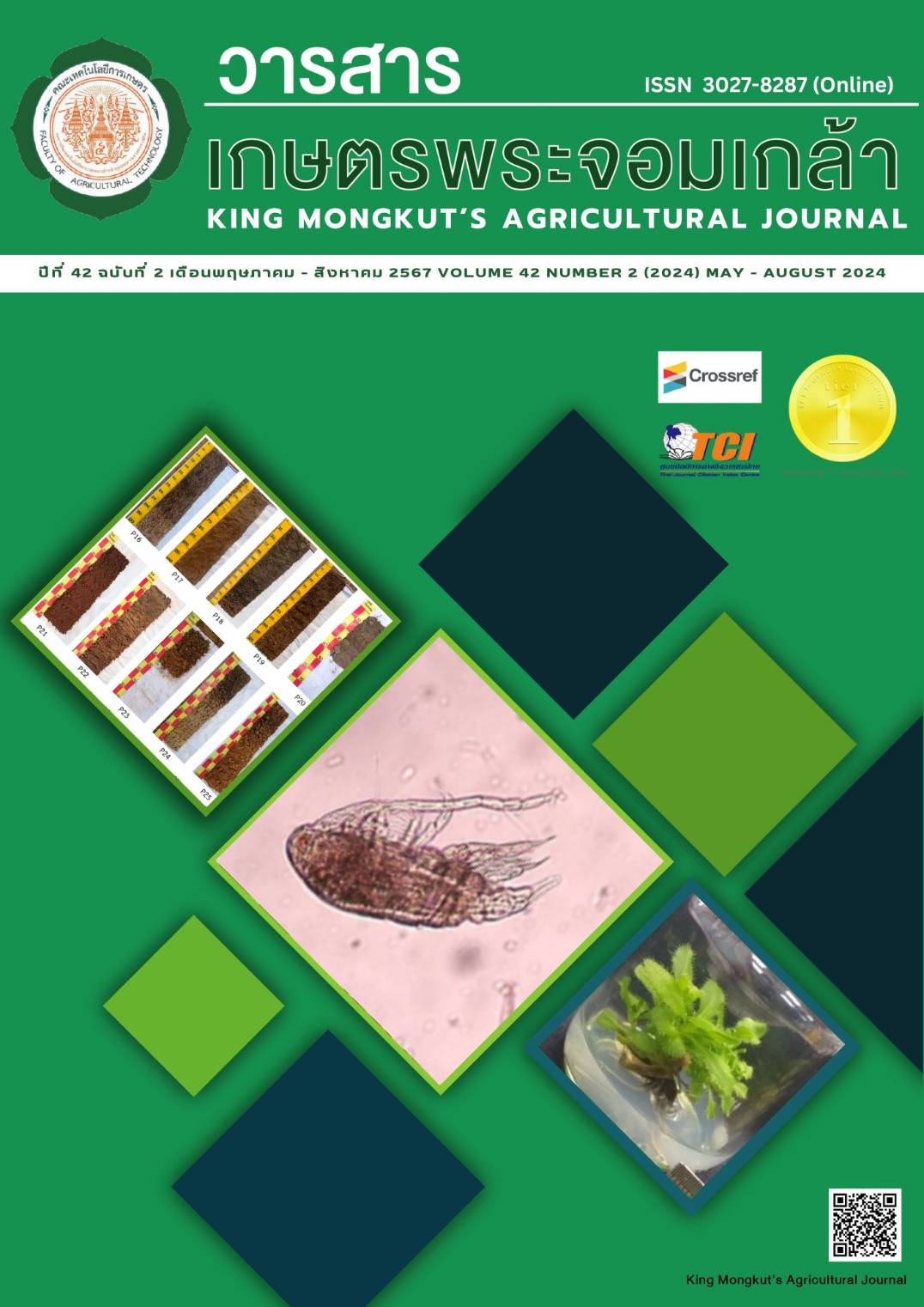ลักษณะทางสัณฐานวิทยาและสมบัติทางฟิสิกส์ของดินบางประการในพื้นที่แสดงโรคต้นและรากเน่า ของมันสำปะหลังในประเทศไทย
Main Article Content
บทคัดย่อ
ทำการศึกษาลักษณะสัณฐานวิทยาของดินและเก็บตัวอย่างดินในพื้นที่ที่มีการเกิดโรครากเน่า โคนเน่า และลำต้นเน่า ของมันสำปะหลังในประเทศไทย เพื่อศึกษาสมบัติทางฟิสิกส์ของดินที่เป็นลักษณะเฉพาะในพื้นที่เกิดโรครากเน่า โคนเน่า และลำต้นเน่า ของมันสำปะหลัง ดำเนินการเก็บตัวอย่างดินในพื้นที่เกิดโรค พร้อมอ้างอิงพิกัดภูมิศาสตร์และข้อมูลดินระดับชุดดินจากแผนที่ดินรายจังหวัดของประเทศไทยของกรมพัฒนาที่ดิน ศึกษาสัณฐานวิทยาของดินโดยการขุดดินด้วยสว่านเจาะดิน เก็บตัวอย่างดินที่ระดับความลึก 0-20, 20-40 และ 40-60 เซนติเมตร เพื่อนำไปวิเคราะห์ เนื้อดิน ความหนาแน่นรวมของดิน และสภาพการนำน้ำของดิน ผลการศึกษาพบว่า พื้นที่เกิดโรคมีลักษณะทางสัณฐานวิทยาของดินที่พบได้คือ การมีชั้นดานแข็ง ดินตื้น การพบจุดประ และการสะสมดินเหนียวในชั้นดินล่าง ผลการวิเคราะห์สมบัติทางฟิสิกส์พบว่าพื้นที่เกิดโรคสามารถเกิดได้ในดินเนื้อหยาบไปจนถึงดินเนื้อละเอียด (ดินทรายถึงดินเหนียว) ดินมีความหนาแน่นรวมสูงในดินล่างอย่างชัดเจน ในขณะที่มีสภาพการนำน้ำของดินอิ่มตัวต่ำในดินล่าง ซึ่งลักษณะทางสัณฐานวิทยาที่พบในพื้นที่เกิดโรคได้แก่ การเป็นดินตื้น การพบจุดประ และการสะสมดินเหนียวในชั้นดินล่าง เป็นไปตามข้อมูลพื้นฐานระดับชุดดิน อย่างไรก็ตามพบว่าการเกิดโรคเป็นผลสืบเนื่องจากการจัดการดินต่อสมบัติดินด้วย ได้แก่การมีชั้นดานไถพรวนระดับตื้น เกิดชั้นแน่นทึบ ความหนาแน่นสูง เป็นข้อจำกัดในการระบายน้ำของดิน ส่งเสริมให้เกิดโรคได้
Article Details

อนุญาตภายใต้เงื่อนไข Creative Commons Attribution-NonCommercial-NoDerivatives 4.0 International License.
วารสารเกษตรพระจอมเกล้า
เอกสารอ้างอิง
Anusontpornperm, S., Nortcliff, S., & Kheoruenromne, I. (2005). Hardpan formation of some coarse-texture upland soils in thailand. In proceeding of Mamngment of Tropical Sandy Soils from Sustainable Agricuture, pp. 285. Land Development Departmment of Thailand.
Anusontpornperm, S., Nortcliff, S., & Kheoruenromne, I. (2009). Interpretability comparison between Soil Taxonomic and Fertility Capability Classification units: a case of some major cassava soils in northeast, Thailand. Kasetsart Journal (Natural Science), 43(5), 9-18.
Blake, G. R., & Hartge, K. H. (1986). Bulk density. In Klute, A. (Ed.), Methods of Soil Analysis Part 1: Physical and Mineralogical Methods, pp. 363-382. American Society of Agronomy.
Boonrawd, S., Anusontpornperm, S., Thanachit, S., Kheoruenromne, I., & Janjirawuttikul, N. (2021). Characteristics and fertility capability of cassava growing soils under different annual rainfall conditions in Northeast Thailand. Khon Kaen Agriculture Journal, 49 (4), 1034-1046.
Charaensatapon, R., Saelee, T., Chulkod, U., & Cheadcoo, S. (2014). Phytophthora root and tuber rot of cassava in Thailand. Book of Abstracts of the 5th Asian Conference on Plant Pathology (ACPP2014), pp. 66. The Empress Convention Center.
Cruz, D. R., Leandro, L. F. S., Mayfield, D. A., Meng, Y., & Munkvold, G. P. (2020). Effects of soil conditions on root rot of soybean caused by Fusarium graminearum. Phytopathology, 110(10), 1604-1736.
Department of Soil Science. (2005). Introduction to Soil Science. 10th ed. Kasetsart University Press.
Jiang, G., Wang, N., Zhang, Y., Wang, Z., Zhang, Y., Yu, J., Zhang, Y., Wei, Z., Xu, Y., Geisen, S., Friman, V. P., & Shen, Q. (2021). The relative importance of soil moisture in predicting bacterial wilt disease occurrence. Soil Ecology Letters, 3, 356-366.
Kheoruenromne, I. (2004). Soil Survey Laboratory Manual. Kasetsart University Press.
Kheoruenromne, I. (2005). Soil Survey. Kasetsart University Press.
Klute, A., & Dirksen, C. (1986). Hydraulic conductivity and diffusivity: Laboratory methods. In A. Klute. (ed.), Methods of Soil Analysis. Part 1: Physical and Mineralogical Methods. Agronomy Monograph, pp. 687-734. American Society of Agronomy.
Land Development Department. (2020a). Characteristics and Soil Properties of Soil Series Established in Thailand. Retrieved from: http://oss101.ldd.go.th/thaisoils_museum/ThaiSoilData_57.htm.
Land Development Department. (2020b). Agri-map. Retrieved from: https://www.ldd.go.th/Agri-Map/Index.html.
Land Development Department. (2020c). Application LDD on Farm Land Use Planning. Retrieved from: https://lddonfarm.ldd.go.th/lddonfarm/main.
Sawatdikarn, S. (2014). Industrial Field Crops. Odeon Store.
Segura, R. A., Stoorvogel, J. J., & Sandoval, J. A. (2022). The effect of soil properties on the relation between soil management and Fusarium wilt expression in Gros Michel bananas. Plant and Soil, 471, 89-100.
Uppapanpongchai, P., Anusontpornperm, S., Thanachit, S., Ketrot, D., & Petprapai, P. (2017). Effect of Cassava Starch Waste, Ground Limestone and Dolomite on Cassava Grown in Satuk Soil. Khon Kaen Agriculture Journal, 45(1), 25-34.
Williamson-Benavides, B. A., & Dhingra, A. (2021). Understanding root rot disease in agricultural crops. Horticulturae, 7(2), 1-43.
Zitnick-Anderson, K., del Río Mendoza, L. E., Forster, S., & Pasche, J. S. (2020). Associations among the communities of soil-borne pathogens, soil edaphic properties and disease incidence in the field pea root rot complex. Plant and Soil, 457, 339-354.


